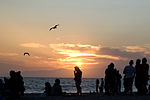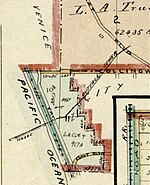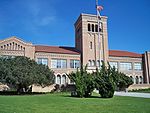Chevron Reef
2000 establishments in California2008 disestablishments in CaliforniaArtificial reefsLandforms of Los Angeles County, CaliforniaLandforms of Southern California ... and 4 more
Natural history of Los Angeles County, CaliforniaReefs of CaliforniaSouth Bay, Los AngelesSurfing locations in California
Chevron Reef, also known as Pratte's Reef, was an artificial reef constructed in 2000 in Santa Monica Bay, offshore from Dockweiler State Beach. It was the first artificial surfing reef in the United States and was the second to be built worldwide. It was removed in 2008.
Excerpt from the Wikipedia article Chevron Reef (License: CC BY-SA 3.0, Authors).Chevron Reef
South Bay Bike Path, Los Angeles
Geographical coordinates (GPS) Address Nearby Places Show on map
Geographical coordinates (GPS)
| Latitude | Longitude |
|---|---|
| N 33.915123 ° | E -118.432624 ° |
Address
South Bay Bike Path
90296 Los Angeles
California, United States
Open on Google Maps









